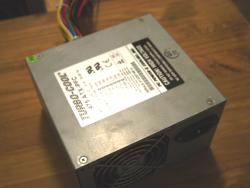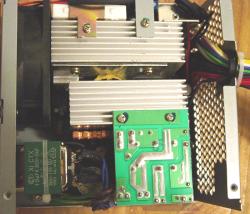2003 Power Supply Roundup Part II: Better Faster Cheaper
by Kristopher Kubicki on July 31, 2003 1:58 PM EST- Posted in
- Cases/Cooling/PSUs
After our last review, we got dozens of emails begging for PCP&C power supplies. Thankfully, our good friends at Directron.com were able to help us obtain a sample. Unfortunately, our initial looks at the unit were slightly mixed.
Our largest amazement was that the TurboCool 475 unit had no power switch. Out of almost 20 represented power supplies, this was the only unit that did not have a simple on/off switch. The TurboCool 475 was also the loudest power supply we had ever heard, definitely louder than the TTGI or Vantec units on full fan speed.
On the other hand, the TurboCool 475 does have a few things going for it. For one, TurboCool is one of the only units we have seen that contains onboard line purification. This definitely will help our signal and generate great results in our ripple test. To justify the loud fan speed, the TurboCool 475 also stays extremely cool during operation, even under load.
Albeit subtle, the TurboCool 475 has variable voltage settings inside the unit. The Antec TrueControl puts them on the fan control in the front of the case, which makes it a little more user friendly. PC Power & Cooling makes you void the warranty to get at the variable voltage controls, so its definitely something that is not recommended unless you know exactly what you are doing.
Wattages
|
|
3.3V |
5V |
12V |
-12 |
-5 |
+5vsb |
combined theoretical |
actual combined |
advertised total |
|
PC Power & Cooling TurboCool 475 |
148.50 |
200.00 |
216.00 |
24.00 |
1.50 |
14.00 |
348.50 |
300.00 |
480.00 |
The TurboCool has an extremely high +3.3V rail. This power supply is geared for the AMD system builder, without a doubt. As a result, the combined +3.3V/+5.0V rail is also quite remarkable; higher than any other power supply we tested. If this is not to your taste you can adjust the voltages on the inside of the unit, although we recommend not voiding the warranty unless you absolutely have no other choice. Remember, playing with the adjustable voltage settings can really mess up your computer. The unit does not come with any ATX sheathing, so you may want to invest in twist ties or some other form of cable management
When we first obtained this sample, it was priced around $180. We never really could figure out why it was priced so high, but over the last couple months the price dropped a little to $165. Even though the TurboCool definitely lacks features, it is the best performer in our benchmark suite. If you are an AMD builder (or overclocker) and you do not mind the loud fan (and high price), this is the power supply for you.













70 Comments
View All Comments
Anonymous User - Sunday, August 3, 2003 - link
While this review is better than most, I feel that the conclusions are flawed. Firstly, there is more to choosing a good PSU than mere performance figures alone, at time of testing, might suggest. Component quality was not taken into account, and is one reason why some PSUs cost more than others.Quality components lead to longer life, higher reliability, and less drifting of specifications over time.
A PSU that appears to be good value for money may not be so good when it fails and takes out your attached devices in the process.
Also, what happened to testing voltage stability under dynamic load conditions. You may find that some units that appeared to show good stability and low ripple under constant load conditions, will perform miserably under dynamic loads, which would be more like the conditions encountered in real usage senarios. Some poor designs may very well cause stability issues under such conditions, which were not apparent in the test results shown.
Good report, but the results are inconclusive.
Anonymous User - Sunday, August 3, 2003 - link
Could you post the settings or source modification to get memtest86 to delay the verify step of the testing?Anonymous User - Sunday, August 3, 2003 - link
Which one is better for a dual ahtlon mp, 64 bits raid 5 (4 disk) and hungry video card???Anonymous User - Sunday, August 3, 2003 - link
OK, I'm confused. Which rail is important to an AMD builder/overclocker? AMD's Power Supply PDF indicates that the mobo's switching power supply uses the 12V rail. My observation of several power supply specs and this article imply that the 3.3V rail actually supplies power to an AMD CPU. This article was clear about P4s using 12V rail. Which is it for AMD?? Or does it depend on the mobo manufacturer and how they decide to build their multi-phase switching regulator?Anonymous User - Sunday, August 3, 2003 - link
Hello,I would like to mention a few pitfalls with your article that are confusing to people I have talked to... Please accept this as constructive criticism as I do not intend to degrade the article in any way.
At first glance, I didn't know what you ment by "Theoretical Combined" in the specification table. I am assuming you did not read this off the power supply's label, but calculated it by adding the 3.3v and 5v lines. While this number (or variation of it) is usefull, I believe that "theoretical" is not the term you are looking for. This is definately NOT the theoretical power output of the combined 3.3/5v rail as the label on the PSU clearly states the theoretical peak power of the combined rail. There is circuitry in the PSU that determines what this theoretical peak power output is for the combined rail, and it has nothing to do with your calculated "theoretical combined" numbers given in the table.
I would encourage you to change the name of that column of your table, and modify the presentation of the number. I recommend giving a power delta from the MFG's specified peak power on the combined rail and your calculated combined rail and call it the "defficiency of combined". For instance: in the case of the Sparkle PSU, the MFG's spec says the combined rail can output a maximum of 220W. Your calculated combined power is 242.4W. I would recommend making the "defficiency of combined" colum state 22.4W. This would give people an idea that there is a 22.4W defficiency that must be spread over the 3.3V and 5V rails in real world usage. This would also reduce the confusion of the incorrect term of "combined theoretical".
The real meaning of "combined theoretical" is really what the MFG's specifications say. The real meaning of "actual combined" is really what you should have measured using something that slowly loads the PSU and then take the highest power output just before overload. I would also recommend that doing this slow power draw, let the PSU stand in that state for a few minutes before increasing power draw again (so increase the draw in steps, with a time interval in between each step) so you can get actual sustained power output.
For a more complete test of each individual rail, blow out 4 different PSU's by maxing out each individual rail, and then trying to max out the combined rail (without maxing out either of the 3.3/5v rails). I know this would be an expensive test, so I would recommend at least doing the latter test if only one PSU is available for testing.Some MFG's are including circuitry to detect overload and are shutting themselves down accordingly while others are just blowing themselves out upon overload. If you frowned upon blown out PSU's because of overloading in your review, it might give PSU MFG's incentive to include this circuitry in future revisions.
I commend you on your memtest86 results. This is a very good idea, and I'm sure it took up much of your time. Thank you for these results.
Caveman2001 - Saturday, August 2, 2003 - link
I posted a comment in the forum "articles" section, but since you removed it, I'll go ahead and repost.Post #15 and #18 have the right info regarding PCP&C silencer PSU's.
I have 2 SILENCER 400W PSU's by them and wouldn't trade it in for anything. As your tests prove, PCP&C make extremely high quality, ripple superior PSU's.
If you overclock, you'll never have to worry about your PSU being the problem if its from them. I hope you guys will get a 400W silencer so you can test and hear the difference.
Anonymous User - Saturday, August 2, 2003 - link
where can i get the modfied memtest86 så that i can try out the shielding test myself ?JPSJPS - Saturday, August 2, 2003 - link
Sorry about the double post! I have been getting timeouts recently here.Anonymous User - Saturday, August 2, 2003 - link
Kristopher - You obviously have spent a *LOT* of time and effort on this article but your technical knowledge is insufficient to produce meaningful valid results. You have made so many glaring technical mistakes/errors (it would take pages to correct them) that everything you presented is suspect.On a positive note, I volunteer to proof/edit/correct any future articles that you propose if you desire. You have my email.
I (JPSJPS) posted a short, minimal critique of your article here but only covered a few major points:
http://forums.anandtech.com/messageview.cfm?catid=...
Regards, JPSJPS
JPSJPS - Saturday, August 2, 2003 - link
KristopherYou obviously have spent a *LOT* of time and effort on this article but your technical knowledge is insufficient to produce meaningful valid results. You have made so many glaring technical mistakes/errors (it would take pages to correct them) that everything you presented is suspect.
On a positive note, I volunteer to proof/edit/correct any future articles that you propose if you desire. You have my email.
I posted a short, minimal critique of your article here but only covered a few major points:
http://forums.anandtech.com/messageview.cfm?catid=...
Regards, John